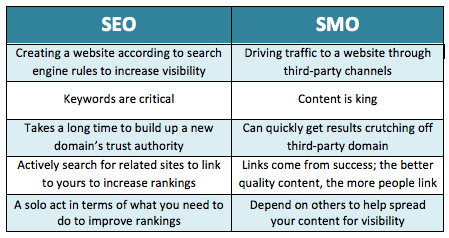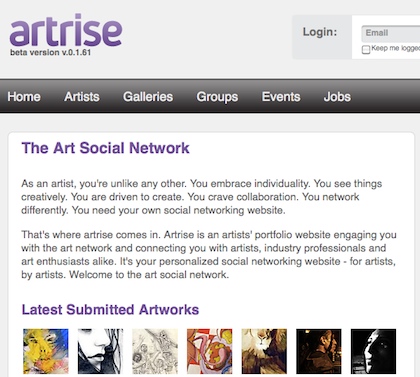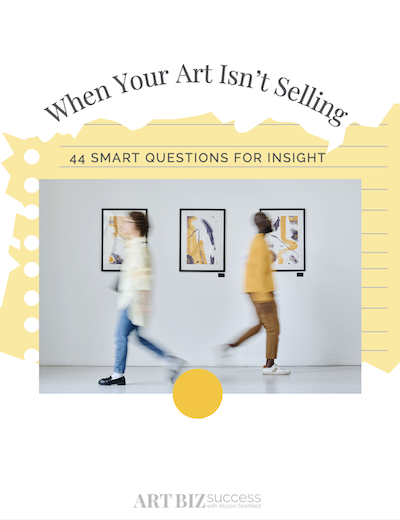Guest Blogger: Erin Everhart
Publishing date: 2010
Don’t just SEO (search engine optimization) your website — SMO your Facebook and Twitter.
There’s been a definite shift in the Web marketing industry. Before, it was all “SEO SEO SEO.” Now, you’re hearing more of an “SMO SMO SMO” tune.
Social media optimization is the new way to position yourself to your audience (and search engines) to better increase your visibility. With one tiny swap of one tiny letter, you’re left re-engineering your web marketing strategy to better service your content with the social media channels your audience is on.
Because we’re the visually orientated types, I’ll summarize what I’m talking about in an artistically pleasing chart before going into a tad more detail.

Some have gone as far to say that SEO is dead, but I’m not that much of an extremist. Besides, SMO derived as a part of SEO, so if one part dies, both parts die.
But SMO is slowly creeping up on the important factor scale when it comes to how visible and attractive a website — nay, a brand — is going to be. This has even further been intensified with the recent announcement of the Facebook/Bing partnership to integrate social results into search results.
We’ve all seen the power of a breaking news tweet or a trending article that’s been passed around Facebook, Twitter and the blogosphere more times than the number of words in said article. More likely than not, there’s good, quality content at the crux of what goes viral. Take something like Atomic Tom’s iPhone Subway Performance. Or Andrew Wyeth’s “Helga.”
This new paradigm is good news for artists, especially those who aren’t technically inclined.
Instead of focusing more attention on manipulating your website’s coding and tags, you can ease back into doing what you do best: producing quality, visually appealing content (whether it’s a blog post, photograph, oil painting, whatever) that will grab your audience’s attention and encourage them to further spread your content to their network. They pass it on to theirs, people in their network discover a new person to connect with (you), and just like that you’ve built up a greater following.
In addition to using your already established social networks, there’s also a new website specifically for artists to better connect them to the right people in the art industry.

UPDATE: ARTRISE LINKS ARE NO LONGER ACTIVE
Artrise is an art social network for all types of artists — photographers, musicians, digital artists, sculptures, you name it — that lets you upload your art and get feedback from peers, meet more people in your industry, and even browse for jobs or events so you can make some money off your art. They’re also currently running a an art contest for users to upload art to their Facebook Wall, get your fans to like it, and the artwork with the most votes wins a grand prize of $1,000. Not a bad way for you to get noticed, and make a little extra cash.
At the root of SMO, though, is creating your presence on any social media channel to be as engaging as possible. This can be done with things like creating a Fan Page, having custom tabs designed to match your personal brand that will reel through some of your latest artwork — You used to be able to also add these to you personal profile page, but Facebook nixed that option on November 3— designing a custom Twitter background that matches your brand while displays some of your artwork, and, again, making sure your written content is up-to-date and enticing.
Here are some basic questions to ask yourself to make sure your website (and hopefully that includes having your blog hosted on your domain) and your social media channels are social media optimized:
- In my online gallery, did I integrate the Facebook Like and Share button on all my artwork and images?
- Am I leaving enough room in Twitter posts so people can retweet me without editing a post?
- Am I consistently putting up good content and good artwork that I’d want to look at if I were someone else?
- Am I making the most of my Facebook page by having a custom landing page that features some of my latest artwork?
About the Guest Blogger
Erin Everhart is a digital strategist, marketing planner and content developer.



13 thoughts on “Beyond SEO: SMO”
Sorry, my experience with Facebook is this: anything posted on Facebook, including images of your art, is subject to Facbook’s copyright and as such, Facebook can use the content as it pleases, that gives me pause; whenever I post a link to my website or a review, it gets no comments (I have been told by my “friends” that they do not follow links); if I post a comment that suggests that I am sad, sick, lonely or grumpy, I get lots of comments. Let me emphasize that any Facebook posting I share that has to do with my art, goes without comment.
There’s certainly some skeptics of Facebook, all mainly concerning the copyright and privacy policy. And there’s definitely going to be a skew in results people see from using Facebook and other social media channels. It’s odd to me how two people can practice the same techniques on Facebook and get such different results, but that may have to do with your followers. Either way, even if you’re not seeing results from using Facebook, I do hope you’re finding out what works best for you to make you a better (and more profitable!) artist. Good luck!
I too have resisted Facebook for the reasons Alfred mentions, but am seriously thinking of joining after weighing the pros and cons and also because it supposedly it reaches a very broad audience.
I was rather disappointed to read the fine print for Artrise and see that it is just as bad as Facebook regarding usage for images posted. I expected more from a company that is specifically targeting artists.
My question is, if you create a fan page on Facebook, how is getting people to look at your Facebook page any different than getting people to look at your website? I know you contact people you already know and ask them to “like” your page, but that would just be a different venue for the same people that already are familiar with my work. Is there a different process on Facebook for getting “fans”?
Thanks Alyson!
Casey, thanks for the comment. I do think Facebook is worth considering joining, mainly because of the amount of connectivity you can have with others. But, as I mentioned to Alfred, it’s odd how results do vary drastically.
For artrise, I certainly understand your concern with the copyright policy. Alyson mentioned that to me prior to this post, and I passed the word on to the founders, Alex Soare and Alex Neculaie, as this is a reasonable concern. The site is currently in beta, so there’s a lot more work that can be done to make it the best place for artists. They’re currently talking things over with their attorneys about the fine print to see what they can do to make you and other artists feel more comfortable. Suggestions like this will certainly make artrise a better place, and we welcome them!
For your last question, I think people are more inclined to “Facebook search” for new people and businesses. People travel through different friends’ profiles and stumble upon friends they didn’t know where on there. That gives creating your profile and fan page a leg up than search engines, which can be hard to get a high enough ranking to be found. Blogging and a Twitter account are also great supplements to reaching new people who aren’t familiar with your work. Following people in the art industry on Twitter is as easy as doing a search for “artists” and instantly you’re connected. When you build up your network, you can bring people to your Facebook page, too.
I hope that helps! There’s a lot more I can discuss about getting fans on Facebook, but I may have already over done it with this comment! 🙂
Thank you Erin. I really appreciate your informative reply and I hope that the powers that be at Artrise will make some changes.
~Casey
1) Facebook allows you to make your posts and images unavailable for use in their internal ads. As far as I know, they don’t take over your image copyrights.
2) To get fans takes some work. It sometimes seems like high school to me where the cliques and “in” people have lots of followers while less popular folks have to scrabble for attention. Nonetheless, I am not convinced that working the crowd can’t make a difference. I have noticed an increase in attention to my fan page the more attention I give it. I am unable, as yet, to discern any trend in what posts or when a post is more or less likely to receive a comment or a “like.”
3) I think this article is both interesting and very timely. For those of us who are not gallery represented and who have control over our own marketing and selling, SMO is perhaps an excellent focus for our attention.
Thanks, Alyson, for publishing this article. I suspect the topic will be added to the next edition of IRBIT…
😉
Patricia
Thanks for the comment, Patricia! I’m glad you enjoyed the article and are seeing the benefits of using Facebook to build your online presence. Social media is a great tool, but it does take a lot of work to see some results. Let me know if you have any questions; I’d be happy to help!
The reason people aren’t clicking on your links is because most workplaces block clicking on links…This means that the people who are reading your Facebook page are surfing from a work computer…The way to deal with this is to make short interesting text that can be digested right on the page…This can be art text-just make it short & no links…
Great point, Sari! Hopefully one day Facebook won’t have to be blocked, but I don’t think that day is going to come any time soon 🙂
Thanks very much for this excellent article!
Thanks Nina! Glad you enjoyed it!
Hey, I’ve had some of the same experience with Facebook which is why I’ve created a twitter account (@esthlete) to promote my art (and other art that I want to see pushed forward.) And I’m a big fan of artists supporting each other. And on twitter that’s as simple as an occasional retweet.
I guess its time for me to switch my focus from SEO to SMO. Thanks for the advice.